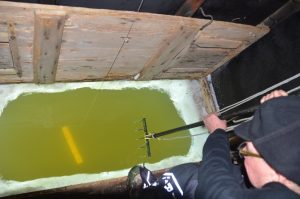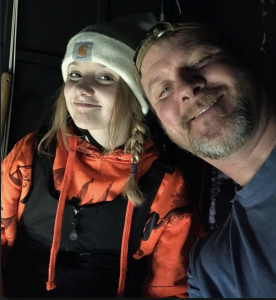Prehistoric fish creates community, camaraderie
March 1, 2022
For up to 16 days each February, a small city pops up on Lake Winnebago as sturgeon spearers come from around the nation for a chance to spear the prehistoric fish that can easily weigh more than 150 pounds.
Spearers cut a hole about 6-feet long and 2.5 feet wide in the ice and sit inside their darkened shanty, staring down at the tinted-colored water in hopes that a sturgeon will swim by. And if one does, they throw their spear and hope their aim is on target.
Sturgeon spearing involves a lot of sitting and waiting. When you do the math, you can understand why.
Lake Winnebago is 131,939 acres, or approximately 30 miles by 10 miles. If the average square footage of a sturgeon hole is 15 feet and there were about 6,000 shanties on the ice, that means the total area of all sturgeon holes on Lake Winnebago is about 2 acres each season. The annual success rate on the lake is usually less than 13%, according to Wisconsin Department of Natural Resources (DNR) data.

Yet year after year, spearers come back, some waiting a decade or longer before they see the bottom-dwelling fish that wears a sort of “armor” with its bony, shell-shaped plates that run the length of their body.
The history of sturgeon spearing is a unique one rooted in the history of the Menominee tribe. The HuntFishTravel blog tells the story of how early European settlers had watched the Menominee people hunt the fish with large spears and took up the practice to help keep their settlements from starving.
However, lake sturgeon are more than just fish to eat for the Menominee people. The sturgeon is part of the creation story of the tribe, and for thousands of years the Menominee people have celebrated each spring to honor the return of the sturgeon to the lake.
The Lake Winnebago system has the world’s largest population of sturgeon estimated at over 19,000 adult females, 24,000 adult males and an undetermined number of juvenile fish, according to a DNR report. But Lake Winnebago is one of only two places in the country where sturgeon spearing is legal. The other place where sturgeon can be speared is Black Lake in Michigan, although that season typically ends in less than a day and is limited to a handful of fish. In 2022, the spearing season on Lake Winnebago lasted the full 16 days as quotas set to protect the species were not met.
The DNR limits the number of fish, both males and females, that can be speared due to the length of time it takes for sturgeon to reproduce. Female sturgeon generally don’t reproduce until they are between 20-26 years old. In addition, females spawn only once every four to nine years while males spawn once every two to seven years.
As this yearly tradition comes along, many people in the community grow eager to get out on the lake. Geoffrey Drews, a father from Appleton, has been spearing since 2001.

Drews grew up in Winneconne and hadn’t gone out until his friend invited him in 2000. The next year, he decided to go out and try spearing himself. As he was sitting in his shanty watching the dark water, one of the massive fish swam across the opening. He was lucky enough to spear a 67-pound fish his first year.
“You go from sitting there staring at the ‘greenscreen’ to spearing a fish!” Drews said. “The fish is thrashing, you and your buddies are trying to pull it up… The sport can be boring with all the sitting and waiting, but it is extremely rewarding.”
Drews has speared five sturgeons in the 20-odd years he has participated in the annual sport. “That’s really great seeing as though some guys don’t see a single sturgeon for 30 years,” he said.
Kayla Enneper grew up in Chilton and has been tagging along with her family every sturgeon season since she was a little girl.
“I went with my mom and dad, they went with their parents, their parents went with their parents. It’s been a tradition in my family for generations,” she said.
Enneper now takes her young boys out. Her husband has also taken up spearing with her brother.
Enneper said the sturgeon spearing season gives her that warm and fuzzy feeling that you got on Christmas morning as a kid.
When her grandfather got too old to fish, he still went out every season to walk around the little village of shanties to chat with the fishermen.
With the rich native history and the close-knit community, sturgeon spearing is an extremely unique sport. Above all, spearing is built on the strong camaraderie of the community around it.
“The community is amazing,” Enneper said. “Sometimes people go out just to stand by the weighing station to see what other people bring in!”

The 2022 season at a glance
- The Wisconsin Department of Natural Resources sold 12,693 sturgeon-spearing licenses that included 12,213 for Lake Winnebago and 480 for the Upriver Lakes of Poygan, Winneconne and Butt des Morts.
- The Upriver Lakes season ended on Feb. 15 as fish quotas were met, but Lake Winnebago’s season lasted the full 16 days and closed on Feb. 27.
- The total number of sturgeon speared on the Lake Winnebago System was 1,518. That included 203 juvenile females, 627 adult females and 688 males.
- A total of 88 sturgeon on the Winnebago System weighed in over 100 pounds making up 5.7% of the total harvest. The largest fish speared was nearly 175 pounds.
Source: Wisconsin DNR















